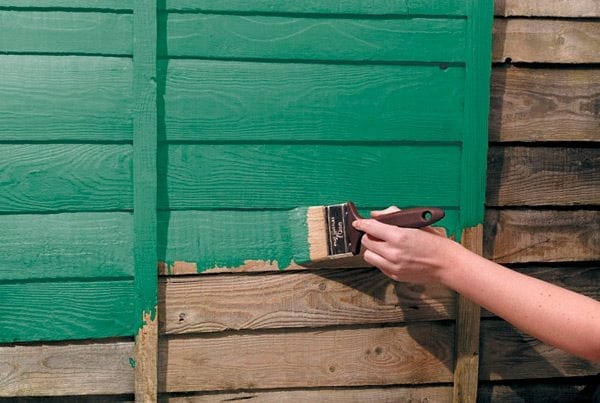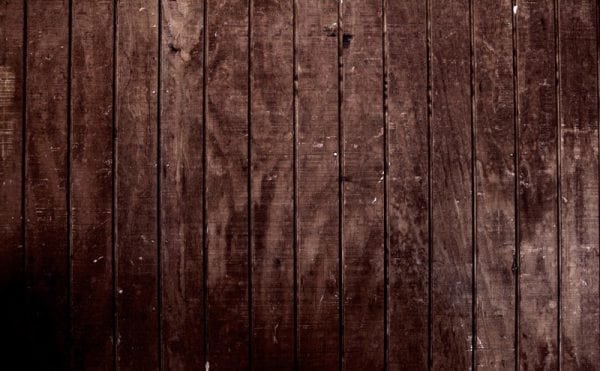Natural wood is considered to be the best building material. Houses made of wood retain heat well, are environmentally friendly and durable if properly maintained. As a finishing material for wooden walls, special paints and varnishes are used. What are they and how to paint a wooden house inside?
- Why do I need to paint a tree
- Coloring materials
- Protective coatings
- Decorative coatings
- Preparation for painting
- How is staining done?
- Ideas and Effects
- Wood texture
- Bleached oak

Why do I need to paint a tree
Some designers leave wooden walls without decoration. And there is an explanation for this: the logs have a rather attractive appearance. Their special pattern, texture and color will undoubtedly decorate any room. But the finish is still needed for the following reasons:
- Wood is highly flammable. The use of special coloring compounds significantly reduces the risk of fire.
- Over time, logs can begin to rot. This completely natural process can be stopped by painting or treating with antiseptic substances.
- The paint will protect the walls from scratches, cracks and other mechanical damage.
- Paint does not change the structure of the tree. She hides his minor flaws and changes his appearance.
- Some substances protect the tree from darkening, creating protection from exposure to sunlight.
Coloring materials
So, how can I paint the wooden walls inside the house? It is impossible to answer this question unequivocally. It all depends on the desired result. Solution Options:
- To provide the walls with protection against mold, fungi, rot and insects, it is enough to stop on antiseptic compounds.
- To give the logs shine, it is better to choose a varnish.
- If the walls need to give color, you will have to purchase paint.
Currently, paints and varnishes are presented in a fairly wide range. Conventionally, they can be divided into two large groups: protective and decorative.
to contents ↑Protective coatings
There are several types:
- Antiseptics. They destroy bacteria and germs, while protecting the walls from mold and rot. When choosing a tool, you should pay attention to the labeling. It should be written there that it is intended for internal work. An antiseptic is an ideal option for those who want to preserve the natural color of the tree.
- Acrylic based varnish. It performs two functions at once: protective and decorative. On sale you can find transparent and translucent acrylic varnish. They can be given the desired shade. The first layer on the walls is recommended to apply a transparent composition, and the second - color. In this case, the structure of the log remains unchanged.
- Synthetic varnishes. Suitable for the walls of those rooms that most of the time are empty. They can be painted, for example, a balcony. As a part of such means usually there is xylene and toluene - these substances carry a certain harm to the person. They give the tree smoothness and luster.
- Products that contain wax. They protect the wooden walls from insects, giving them a pleasant semi-gloss shine. Their only drawback is a rather complicated application process.
Decorative coatings
Completely change the color of the wooden wall. Used as initial coating:
- Oil paint.The leader in the market of paints and varnishes. Such popularity is due to its high penetrating ability. It protects the tree from mechanical damage and moisture. For more than seven years, the oil coating does not fade and does not lose its luster. But the coating also has several disadvantages, for example, a strong chemical smell. Because of it, it becomes impossible to paint the walls in the cold season, when there is no way to ventilate the room well.
- Acrylate coating. The composition is similar to oil paint, but does not have its drawbacks. To the benefits acrylate paint include quick drying, the absence of a strong odor and the ability to carry out work indoors without restrictions. Such paint is not exposed to moisture and high or low temperatures. The coating for many years remains bright and shiny. Its disadvantages include a rather high price.
- Water based acrylic lacquer. This is the perfect solution for painting walls inside a wooden house. It has several advantages: it is absolutely non-toxic; Suitable even for a children's room or bedroom; It is a hypoallergenic agent.
- In the event that it is only necessary to slightly change the shade of the tree, it is better to use a stain.
Preparation for painting
In the process, such tools and materials may come in handy:
- protective gloves;
- a ladder of the required length;
- a bucket or any other container for paint;
- sandpaper for cleaning and polishing walls;
- brush;
- work clothes;
- just in case - the means by which you can remove the paint from the skin;
- metal brush;
- primer;
- means for whitening a wooden wall;
- paint, varnish or other coloring agent;
- impregnation.
After all the tools and additional materials are ready, you need to prepare the work surface. This process can be of two types: preparation of walls for the first and repeated painting.

When choosing wood for building a house, it is better to choose one that is already covered with an antiseptic. "Factory" coverage is much better and more practical. If it is not possible to purchase an already processed wood, then the antiseptic will have to be applied independently.
First, the walls need to be cleaned of dust, debris and dirt, and after that you can take on an antiseptic. The range of these funds is quite wide. There are even special antiseptic primers, and it is worth choosing them. After staining, you need to wait for complete drying and only then apply the paint.
There is one caveat: it is better to carry out antiseptic treatment before the construction of the house begins. So it will be possible to protect the logs from all sides.
If the tree has already been painted earlier, you need to act a little differently. Using a metal brush or special washes, remove the old paint. The main thing is not to overdo it and not damage the wooden base. If you scratch its surface with a brush, you will have to do additional grinding.
If dark spots appear on the surface of the paint under a layer of paint, we recommend using bleaching agents. There are times when they do not help. Then it is worth applying a layer of clarifying stain.
As soon as the walls are clean of paint, you can apply an antiseptic solution or primer. This should be done after the clarifying agent has dried.
to contents ↑An important point: before using the primer, it is advisable to sand the wall with sandpaper.
How is staining done?
Painting walls in a wooden house is quite simple, if you follow a few useful tips:
- The number of layers depends on the type of dye. As a rule, there should be no more than two.Detailed instructions on this should be written on the packaging or in the instructions.
- Do not apply one thick layer. Let them be few, but subtle. The thick layer will flow, and its service life is much shorter.
- When painting, do not press hard on the brush or roller. They must be moved smoothly along the painted surface.
- We must not forget about inaccessible places. A separate thin brush should be prepared for them.
- If after working with a brush the fibers remain, a roller should be taken.
Ideas and Effects
Is it possible to preserve the wood pattern when painting wooden walls or, for example, to achieve the effect of bleached oak? You can, and there are some tips for this.
Wood texture
To save it, such paints and varnishes as azure, oils or waxes with pigments in their composition will help. They lie in a dense even layer. In the process of staining, you can use a brush or roller.
The painting process has its own characteristics. First, the coloring composition is applied to the surface in small quantities. Then it is shaded with a brush or roller. After this, the wall must be left for approximately 10 minutes, so that the product is absorbed. Next, using a lint-free cloth, you should remove its excess. There will be enough material left in the cracks and grooves of wood to emphasize the texture. Thus, it is possible to process both the walls and the ceiling.
to contents ↑Bleached oak
This effect involves painting the wooden surface so that the streaks remain visible. You can create it in several ways:
- Using a stain of the same name. There is one caveat in its use: if you apply too much, the coating will begin to peel off over time. It is better to make several thin layers. Moreover, each subsequent one is recommended to be applied after the previous one has completely dried.
- Using special oil with wax. It can be applied in two layers or one. In the second case, you will have to polish the surface with a soft cloth.
- This effect can also be created using pigmented polyurethane primer. It must be mixed with diluent. The amount of diluent is about 80% of the total volume.
- Acrylic primer with pigment. Like the previous tool, it requires the use of a diluent. Its main advantage is that the coating does not turn yellow over time.
So, you can and should paint a wooden house from the inside. All kinds of paints and varnishes will only improve the properties of wood, help emphasize its texture and change color. Using different means, you can achieve different effects.









